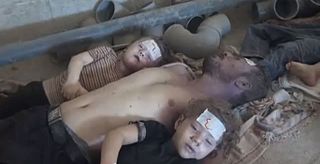2013 Ghouta attacks
| Ghouta chemical attack | |
|---|---|
| Part of the Syrian Civil War | |

Some of the victims of the Ghouta chemical attack
|
|
| Location | Ghouta, Syria |
| Coordinates | Eastern Ghouta: within 750 meters (2,460 ft) from 33°31′26″N 36°21′24″E / 33.5238301°N 36.3566995°E Western Ghouta: within 500 meters (1,600 ft) from 33°27′37″N 36°11′50″E / 33.4602966°N 36.1972287°E |
| Date | 21 August 2013 |
|
Attack type
|
Chemical attack |
| Deaths | Various estimates: at least 281 (French intelligence) at least 350 (UK intelligence) 355 (MSF) 494 (Damascus Media Office) 502 (SOHR) 635 (SRGC) 923 (VDC) 1,300 (SNC) 1,338 (LCC) 1,429 (United States) 1,729 (FSA) |
|
Non-fatal injuries
|
3,600 patients displaying neurotoxic symptoms in 3 hospitals supported by MSF |
| Perpetrators | Unknown |
The Ghouta chemical attack occurred in Ghouta, Syria, during the Syrian Civil War in the early hours of 21 August 2013. Two opposition-controlled areas in the suburbs around Damascus, Syria were struck by rockets containing the chemical agent sarin. Estimates of the death toll range from at least 281 people to 1,729. The attack was the deadliest use of chemical weapons since the Iran–Iraq War.
Inspectors from the United Nations Mission already in Syria to investigate an earlier alleged chemical weapons attack, requested access to sites in Ghouta the day after the attack, and called for a ceasefire to allow inspectors to visit the Ghouta sites. The Syrian government granted the UN's request on 25 August, and inspectors visited and investigated Moadamiyah in Western Ghouta the next day, and Zamalka and Ein Tarma in Eastern Ghouta on 28 and 29 August.
The UN investigation team confirmed "clear and convincing evidence" of the use of sarin delivered by surface-to-surface rockets, and a 2014 report by the UN Human Rights Council found that "significant quantities of sarin were used in a well-planned indiscriminate attack targeting civilian-inhabited areas, causing mass casualties. The evidence available concerning the nature, quality and quantity of the agents used on 21 August indicated that the perpetrators likely had access to the chemical weapons stockpile of the Syrian military, as well as the expertise and equipment necessary to manipulate safely large amount of chemical agents." It also stated that the chemical agents used in the Khan al-Assal chemical attack "bore the same unique hallmarks as those used in Al-Ghouta."
The Syrian opposition, as well as many governments, the Arab League and the European Union stated the attack was carried out by forces of Syrian President Bashar al-Assad. The Syrian and Russian governments blamed the opposition for the attack, the Russian government calling the attack a false flag operation by the opposition to draw foreign powers into the civil war on the rebels' side.Åke Sellström, the leader of the UN Mission, characterized government explanations of rebel chemical weapons acquisition as unconvincing, resting in part upon "poor theories."
...
Wikipedia
